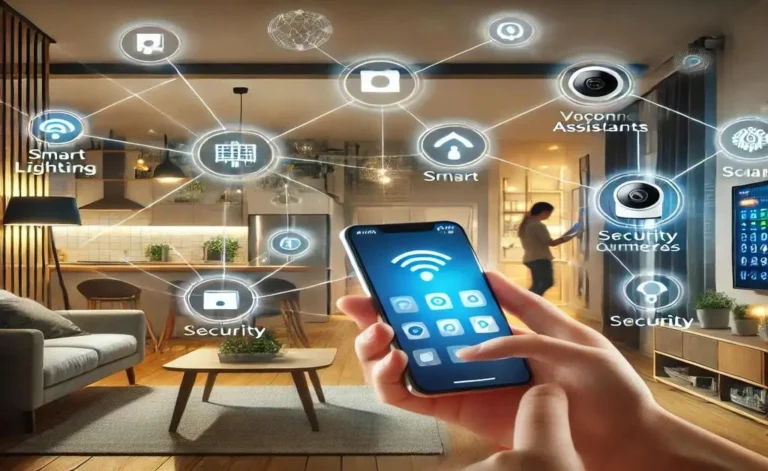Imagine waking up to the gentle hum of your favorite song as the blinds slowly open to let in the morning sun. Your coffee maker starts brewing your preferred blend, and the thermostat adjusts to the perfect temperature—all without you lifting a finger. This isn’t a scene from a futuristic movie; it’s the reality of smart home technology today.
What Is Smart Home Technology?
At its core, smart home technology refers to devices and systems in your home that connect to the internet, allowing you to control and monitor them remotely. These gadgets communicate with each other, creating a network of interactive and automated tools designed to make your life more convenient, efficient, and secure.
The Evolution of Smart Homes
The journey of smart homes began with simple remote controls for televisions and garage doors. Over time, advancements in technology have transformed our living spaces into interconnected hubs of innovation. The introduction of Wi-Fi, smartphones, and voice assistants has accelerated this evolution, making it easier than ever to integrate smart devices into our daily routines.
Benefits of Adopting Smart Home Technology
- Enhanced Security
- Smart Security Cameras: Monitor your property in real-time from anywhere in the world. Receive instant alerts if unusual activity is detected.
- Smart Locks: Grant access to trusted individuals remotely and keep track of who enters and exits your home.
- Energy Efficiency
- Smart Thermostats: Learn your schedule and adjust heating or cooling accordingly, reducing energy consumption.
- Smart Lighting: Automatically turn off lights in unoccupied rooms and adjust brightness based on natural light availability.
- Convenience and Comfort
- Voice Assistants: Control multiple devices with simple voice commands.
- Automated Routines: Set up sequences where multiple actions occur with a single command. For example, saying “Goodnight” could turn off lights, lock doors, and adjust the thermostat.
- Cost Savings
- Energy Monitoring: Track your energy usage and identify areas where you can cut back, leading to lower utility bills.
- Preventative Maintenance: Smart appliances can alert you to potential issues before they become costly repairs.
Popular Smart Home Devices
- Smart Speakers and Voice Assistants
- Amazon Echo with Alexa: A versatile device that plays music, answers questions, and controls other smart devices.
- Google Nest Audio with Google Assistant: Offers high-quality sound and seamless integration with other Google services.
- Smart Lighting
- Philips Hue Bulbs: Customize colors and brightness to suit any mood or occasion.
- LIFX Smart Bulbs: Wi-Fi-enabled bulbs that don’t require a hub and offer a wide range of colors.
- Smart Thermostats
- Ecobee SmartThermostat: Features room sensors to manage hot or cold spots and integrates with various smart home systems.
- Nest Learning Thermostat: Adapts to your schedule and preferences over time, optimizing energy usage.
- Smart Security Systems
- Ring Video Doorbell: See, hear, and speak to visitors at your door from your smartphone.
- Arlo Pro Security Cameras: Wireless cameras with high-definition video and advanced motion detection.
- Smart Appliances
- Samsung Family Hub Refrigerator: Features a touchscreen that lets you see inside without opening the door, stream music, and more.
- LG Smart Washer and Dryer: Allows you to start or monitor laundry cycles from your smartphone.
Setting Up Your Smart Home: A Step-by-Step Guide
Embarking on the journey to create a smart home can seem daunting, but breaking it down into manageable steps can simplify the process.
1. Assess Your Needs
- Identify Pain Points: Determine which tasks you want to automate or control remotely. For instance, if you often forget to turn off lights, smart bulbs might be a good start.
- Prioritize Devices: Decide which devices will have the most significant impact on your daily life and start with those.
2. Ensure a Strong Wi-Fi Network
- Upgrade Your Router: A robust and reliable Wi-Fi connection is the backbone of any smart home. Consider investing in a high-quality router or a mesh Wi-Fi system to cover larger areas.
- Secure Your Network: Protect your network with strong passwords and consider setting up a separate network for your smart devices to enhance security.
3. Choose a Smart Home Ecosystem
- Compatibility: Select a primary platform (such as Amazon Alexa, Google Assistant, or Apple HomeKit) to ensure that your devices can communicate seamlessly.
- Future Expansion: Consider the ecosystem’s flexibility and the availability of compatible devices for future additions.
4. Start with a Central Hub
- Smart Speakers: Devices like the Amazon Echo or Google Nest Hub can serve as central controllers for your smart home.
- Dedicated Hubs: Some systems may require specific hubs to function correctly. Research your chosen devices to determine if a dedicated hub is necessary.
5. Integrate Devices Gradually
- Begin with Basics: Start with essential devices like smart bulbs or plugs to get accustomed to the technology.
- Expand Over Time: As you become more comfortable, add more complex devices like thermostats, security systems, or appliances.
6. Set Up Automation and Routines
- Create Scenes: Configure multiple devices to work together based on your routines. For example, a “Morning” scene could gradually turn on lights, start the coffee maker, and play your favorite news podcast.
- Utilize Sensors: Incorporate motion sensors or door sensors to trigger specific actions, such as turning on hallway lights when motion is detected at night.
7. Regular Maintenance and Updates
- Firmware Updates: Keep your devices updated to ensure they have the latest features and security patches.
- Review Automations: Periodically assess your automations to ensure they still align with your routines and make adjustments as needed.
Overcoming Common Smart Home Challenges
While smart home technology offers numerous benefits, it’s essential to be aware of potential challenges and how to address them.
1. Compatibility Issues
- Research Before Purchase: Ensure that new devices are compatible with your existing ecosystem.
- Universal Platforms: Consider using platforms that support a wide range of devices, such as Amazon Alexa or Google Assistant.
2. Privacy Concerns
- Data Security: Choose reputable brands known for robust security measures.
- Manage Permissions: Regularly review and adjust device permissions and understand what data is being collected.
3. Technical Difficulties
- User Manuals and Support: Familiarize yourself with device manuals and don’t hesitate to contact customer support when needed.
- Online Communities: Engage with online forums and communities where users share solutions to common issues.
The Future of Smart Home Technology
The landscape of smart home technology is continually evolving. Emerging trends include:
- Artificial Intelligence Integration: Devices are becoming smarter, learning from your habits to provide more.



